EARTH’S ATMOSPHERE

The blanket of gas on the surface of a planet or satellite is known as ATMOSPHERE. Atmosphere of the Earth reaches out to about 10,000 km into the space but the thickest part is within the first 50 km only from the surface. The Troposphere, Stratosphere, Mesosphere, Thermosphere and Exosphere are the main five layers of it. The bulk of the Earth’s atmosphere is down near the Earth itself. In fact, 75% of the Earth’s atmosphere is contained within the first 11 km above the planet’s surface. However, the outermost layer (the Exosphere) is the largest, extending from the exobase – located at the top of the thermosphere at an altitude of about 700 km above sea level – to about 10,000 km . The exosphere merges with the emptiness of outer space, where there is no atmosphere. As a rule, air pressure and density decrease the higher one goes into the atmosphere and the farther one is from the surface.
TROPOSPHERE : the lowest region of the atmosphere, extending from the earth's surface to a height of about 6–10 km.
STRATOSPHERE : the layer of the earth's atmosphere above the troposphere, extending to about 50 km above the earth's surface.
MESOSPHERE : the region of the earth's atmosphere above the stratosphere and below the thermosphere, between about 50 and 80 km in altitude.
THERMOSPHERE : the region of the atmosphere above the mesosphere and below the height at which the atmosphere ceases to have the properties of a continuous medium. The thermosphere is characterized throughout by an increase in temperature with height.
EXOSPHERE : the outermost region of a planet's atmosphere.
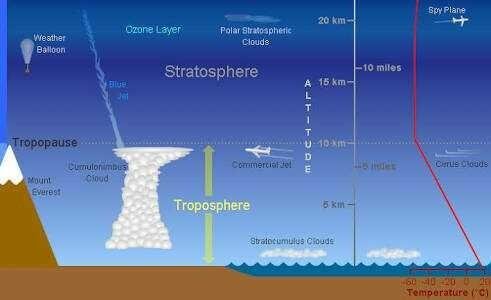
The TROPOSPHERE is the lowest layer of Earth's atmosphere, and is also where nearly all weather conditions take place. It contains approximately 75% of the atmosphere's mass and 99% of the total mass of water vapor and aerosols. The average depths of the troposphere are 18 km in the tropics, 17 km in the mid latitudes, and 6 km in the polar regions in winter. The lowest part of the troposphere, where friction with the Earth's surface influences air flow, is the planetary boundary layer. This layer is typically a few hundred meters to 2 km deep depending on the landform and time of day. Atop the troposphere is the tropopause, which is the border between the troposphere and stratosphere. The tropopause is an inversion layer, where the air temperature ceases to decrease with height and remains constant through its thickness.
The word troposphere derives from the Greek: tropos for turn, turn toward, trope and sphere (as in, the Earth), reflecting the fact that rotational turbulent mixing plays an important role in the troposphere's structure and behaviour. Most of the phenomena associated with day-to-day weather occur in the troposphere.
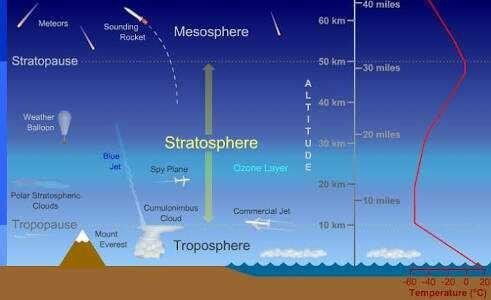
The STRATOSPHERE is the second major layer of Earth's atmosphere, just above the troposphere, and below the mesosphere. About 20% of the atmosphere's mass is contained in the stratosphere. The stratosphere is stratified in temperature, with warmer layers higher and cooler layers closer to the Earth. The increase of temperature with altitude is a result of the absorption of the Sun's ultraviolet radiation by the ozone layer. This is in contrast to the troposphere, near the Earth's surface, where temperature decreases with altitude. The border between the troposphere and stratosphere, the tropopause, marks where this temperature inversion begins. Near the equator, the stratosphere starts at 18 km ; at mid latitudes, it starts at 10–13 km and ends at 50 km ; at the poles, it starts at about 8 km . Temperatures vary within the stratosphere with the seasons, in particular with the polar night . The greatest variation of temperature takes place over the poles in the lower stratosphere; variations at lower latitudes and higher altitudes are smaller. Winds in the stratosphere can sometimes exceed 300 MPH, relative to the ground.
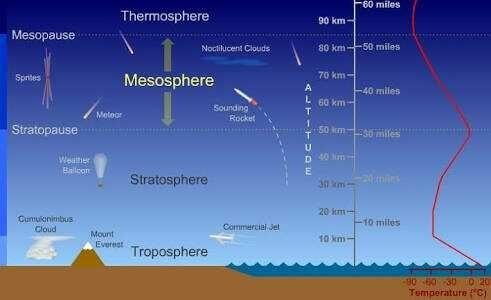
The MESOSPHERE is the layer of the Earth's atmosphere that is directly above the stratosphere and directly below the mesopause. In the mesosphere, temperature decreases as the altitude increases. The upper boundary of the mesosphere is the mesopause, which can be the coldest naturally occurring place on Earth with temperatures below −143 °C . The exact upper and lower boundaries of the mesosphere vary with latitude and with season, but the lower boundary of the mesosphere is usually located at heights of about 50 kilometres above the Earth's surface and the mesopause is usually at heights near 100 kilometres , except at middle and high latitudes in summer where it descends to heights of about 85 kilometres .
The stratosphere, mesosphere and lowest part of the thermosphere are collectively referred to as the middle atmosphere, which spans heights from approximately 10 kilometres to 100 kilometres . The mesopause, at an altitude of 80–90 km , separates the mesosphere from the thermosphere—the second-outermost layer of the Earth's atmosphere. This is also around the same altitude as the turbopause, below which different chemical species are well mixed due to turbulent eddies. Above this level the atmosphere becomes non-uniform; the scale heights of different chemical species differ by their molecular masses.
The term near space is also sometimes used. This term does not have a technical definition, but typically refers the region of the atmosphere up to 100 km , roughly between the Armstrong limit (above which humans need a pressure suit to survive) up to the Kármán line where astrodynamics must take over from aerodynamics in order to achieve flight. The definition of near space can vary depending on the source, but in general near space comprises the altitudes above where commercial airliners fly but below orbiting satellites. Some sources distinguish between the terms near space and upper atmosphere, so that only the layers closest to the Karman line are called near space.
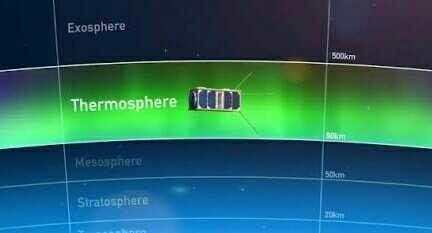
The THERMOSPHERE is the layer of the Earth's atmosphere directly above the mesosphere and below the exosphere. Within this layer of the atmosphere, ultraviolet radiation causes photoionization/photodissociation of molecules, creating ions in the ionosphere. Taking its name from the Greek thermos meaning heat, the thermosphere begins about 85 kilometres above the Earth. At these high altitudes, the residual atmospheric gases sort into strata according to molecular mass. Thermospheric temperatures increase with altitude due to absorption of highly energetic solar radiation. Temperatures are highly dependent on solar activity, and can rise to 2,000 °C . Radiation causes the atmosphere particles in this layer to become electrically charged, enabling radio waves to be refracted and thus be received beyond the horizon. In the exosphere, beginning at 500 to 1,000 kilometres above the Earth's surface, the atmosphere turns into space, although by the criteria set for the definition of the Kármán line, the thermosphere itself is part of space.
The highly diluted gas in this layer can reach 2,500 °C during the day. Even though the temperature is so high, one would not feel warm in the thermosphere, because it is so near vacuum that there is not enough contact with the few atoms of gas to transfer much heat. A normal thermometer might indicate significantly below 0 °C , at least at night, because the energy lost by thermal radiation would exceed the energy acquired from the atmospheric gas by direct contact. In the anacoustic zone above 160 kilometres , the density is so low that molecular interactions are too infrequent to permit the transmission of sound.
The dynamics of the thermosphere are dominated by atmospheric tides, which are driven by the very significant diurnal heating. Atmospheric waves dissipate above this level because of collisions between the neutral gas and the ionospheric plasma.
The International Space Station orbits the Earth within the middle of the thermosphere, between 330 and 435 kilometres .
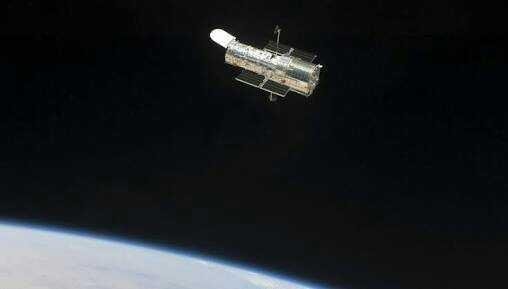
The EXOSPHERE is a thin, atmosphere-like volume surrounding a planet or natural satellite where molecules are gravitationally bound to that body, but where the density is too low for them to behave as a gas by colliding with each other. In the case of bodies with substantial atmospheres, such as Earth's atmosphere, the exosphere is the uppermost layer, where the atmosphere thins out and merges with interplanetary space. It is located directly above the thermosphere. Very little is known about it due to lack of research.
Mercury and several large moons, such as the Moon and the Galilean satellites of Jupiter, have exospheres without a denser atmosphere underneath, referred to as a surface boundary exosphere. Here, molecules are ejected on elliptic trajectories until they collide with the surface. Smaller bodies such as asteroids, in which the molecules emitted from the surface escape to space, are not considered to have exospheres.
THANKS FOR READING @facttechz

Thanks for the informative article. Keep calm and keep Steeming :)
This post has been rewarded with 30% upvote from @indiaunited-bot account. We are happy to have you as one of the valuable member of the community.
If you would like to delegate to @IndiaUnited you can do so by clicking on the following links: 5SP, 10SP, 15SP, 20SP 25SP, 50SP, 100SP, 250SP. Be sure to leave at least 50SP undelegated on your account.
Please contribute to the community by upvoting this comment and posts made by @indiaunited.
This is really an educational and informative post. Looks good for science students..
Its nice to know about the atmosphere , and every thing, good info keep it up
this is informative and interesting, thank you very much for writing about our atmosphere
Released on: May 14th
As a friendly reminder, the current upvote fee is $0.12 SBD ($0.121 for incognito). Current 300%+ upvote is now $0.36+ SBD.
Join our 10 SP Challenge!!!
Simply click this link to delegate 10 SP Now!
Or delegate any of these other amounts and make a "striking" return on your investment!
50 SP --- 100 SP --- 200 SP --- 500 SP --- 1000 SP
That being said...
Investors who delegate SP to @thundercurator are entitled to 75% of @thundercurator income after curation. Get on-board early and grow with us!
Well effort.
keep it up the good work.
Thank you
Good Post and it is informative @facttechz
This is really an educational and informative post. bery good
https://en.wikipedia.org/wiki/Exosphere
plagiarism - copying another artist or authors work without a source or citation, which leads others to believe it is your own original work.